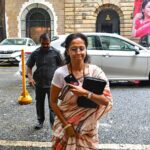Among the less well-known winners in Sri Lanka’s parliamentary election last week was Krishnan Kalaichelvi, the daughter of a Malaiyaga Tamil tea-estate worker. In the annals of South Asia’s mistreatment of minorities, the Malaiyaga occupy a tragic place.
They were brought to the island as indentured labourers in the 19th century by the British, with hundreds of thousands then forcibly repatriated to Tamil Nadu after an inhumane agreement between India and Sri Lanka in the mid-1960s. This is a community that would seem unlikely supporters of the Janatha Vimukthi Peramuna (JVP)-led National People’s Power party (NPP).
Yet, by focusing on economic hardships and convincing voters across the country that the party has a changed approach to minorities, the NPP won a two-thirds majority in parliament, a feat no other party has achieved.
With the huge mandate for saba wensak, or genuine change in Sinhala, President Anura Kumara Dissanayake must push through reforms such as the devolution of power to the north and east—and an even more tricky revamp of the economy, so that Sri Lanka can begin to pay off its huge international debts from 2028 onwards.
The breadth of support he has received in the north and east, where he had performed poorly in the presidential election in September, is an advantage. Contrary to the cliché, less than two months is actually a short time in politics, especially for a seismic shift in voter loyalties to the NPP from parties that once had solid minority support.
Yet, that is what has happened. In this annus horribilis of elections worldwide that have been influenced by social media strategies that plumbed new levels of viciousness, Sri Lanka’s metamorphosis from a moth flying towards a flame into a butterfly is the most heartening.
Dissanayake has not struck a false political note since he became president in September. Within days, he was in a Hindu temple declaring he would work for all Sri Lankans.
His Diwali greetings called on the country to turn its back on divisiveness and embrace an “attitudinal transformation” that embodied compassion and critical thinking. Circa 2024, such good sense from leaders counts as revolutionary.
Sri Lanka’s economic to-do list is a tall order. It must ramp up its GDP growth rate by diversifying its export base, join free trade agreements such as the Regional Comprehensive Economic Partnership (RCEP), forge a trade pact with India, and ease the burden on the quarter of its population now classified as poor since the country declared bankruptcy in 2022.
But it is not clear if the remarkable team leading Sri Lanka, including Prime Minister Harini Amarasuriya, a PhD in anthropology who did an undergraduate degree at Delhi’s Hindu College, has sized up the economic mountains to be climbed as adeptly as it has grasped the country’s political challenges, which include high-profile prosecutions for corruption as well as full investigations of Sri Lanka’s horrific Easter terrorist attack in 2019 and targeted killings 15 years ago.
Calls by NPP leaders to renegotiate the country’s deal with the International Monetary Fund (IMF) sound good along a campaign trail but are impractical. Veering off course would undo the stability of its economy and currency seen over the past year.
There are a host of clever Sri Lankan economists: One of them could have been a technocratic finance minister just as Manmohan Singh was in crafting India’s 1991 turnaround after it went to the IMF. Dissanayake has so far kept the finance portfolio with himself.
This puzzling decision comes after tired homilies to Karl Marx at the party’s victory celebration last week. Never mind that comrades from the Chinese Communist Party’s state-owned enterprises were enthusiastic handmaidens of the Rajapaksa family in building white elephants—including a huge port and a ghost airport in southern Sri Lanka—and saddling Sri Lanka with huge debts in the bargain.
Among these is a multi-purpose giant auditorium so badly made by the Chinese that a leading orchestra from Shanghai initially refused to perform there. In 2022, Bloomberg Businessweek quoted a government official as saying that “pilfered assets could amount to $18 billion.”
The country’s economy requires building on past successes in tourism, tea and garments while diversifying to new export industries. Prasenjit Basu, former chief economist for Credit Suisse for Southeast Asia and India, points to the Philippines as a possible model where a former military base has become a centre for foreign business process outsourcing centres (including Indian ones).
The IMF’s demand for more transparent public procurement (supported by the new government) is essential: A contract for processing visas given to a consortium including VFS Global was overturned by the local Supreme Court in August. Dissanayake moved quickly to return to the efficient old system.
The government’s reversal of plans to privatize Sri Lankan Airlines, however, reflects muddled thinking. The airline is a shadow of what it was when it was privately run. In no Asian capital is the gap between grim economic reality and huge economic potential so wide.
Yet, urgently recasting the Sri Lankan economy as repayments of billions of dollars in debt come due from 2028 onwards is akin to practising balletic spins on the edge of a cliff. Singing loudly from a tired socialist song-sheet will make this harder still.
#Dissanayake #administrations #challenge #reform #Sri #Lankas #economy


